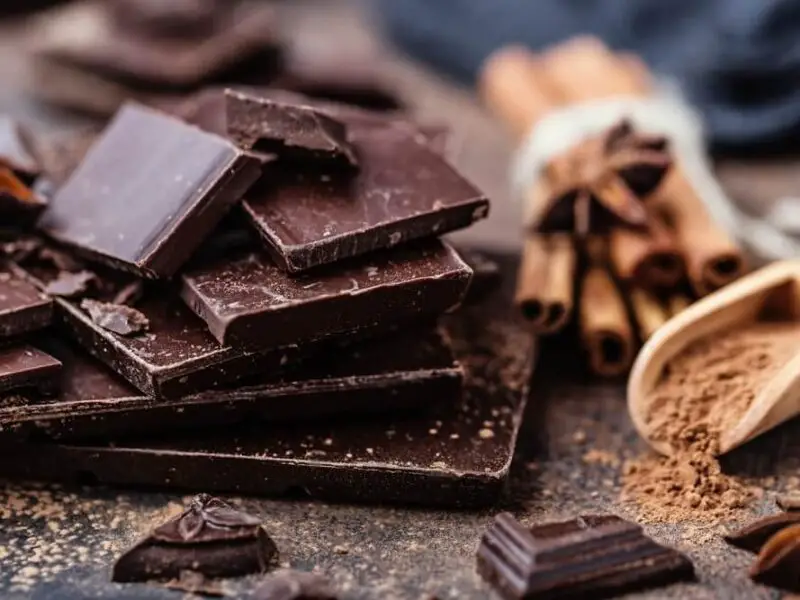Have you ever found yourself in the baking aisle, excited to whip up a batch of decadent chocolate brownies, only to realize you’re one crucial ingredient short—chocolate extract? I’ve been there, staring down at that tiny bottle of concentrated cocoa magic, panicking at the thought of ruining dessert without it. But never fear, chocolate lovers—where there’s a will, there are ways. Through some trial and error, I’ve discovered some sneaky substitutes that can save any recipe from disaster.
In this article, I’ll let you in on my best-kept secrets for replacing chocolate extract without compromising on flavor. From pantry staples to unexpected tricks of the trade, we’ll explore easy and delicious options for stepping in when that tiny bottle goes mysteriously missing. Your sweet tooth will thank you; read on for solutions to satisfy any chocolate craving!
Best Chocolate Extract Substitutes
1. Vanilla Extract
When all else fails, vanilla extract is my go-to chocolate extract substitute. Now I know what you’re thinking – vanilla in chocolate? But trust me on this one. As it turns out, vanilla’s subtle notes complement chocolate in a unexpected but magical way.
Reach for the vanilla anytime the chocolate runs out. Use a simple 1:1 ratio – one tablespoon of vanilla for each tablespoon of missing chocolate extract. I was skeptical at first too, but once I gave it a try I was blown away. The vanilla enhances and brings forward the cocoa without being overly prominent itself.
It’s the most accessible substitute as well. Chances are you already have a bottle of vanilla stashed away, versus running to the store at the last minute if you’re missing some specialty ingredient. And really, what home baker doesn’t always need more vanilla in their life?
2. Semi-Sweet Chocolate
When the flavor needs to pop with intense chocolate richness, reach for some semi-sweet chocolate chips or chunks. This substitute delivers big on taste without the boozy note of extract.
Simply measure out 1/2 ounce of chocolate for every tablespoon of extract called for. But that chocolate will add more than just flavor – it also brings sweetness to the party. So to compensate, add a teaspoon of granulated sugar per measured ounce of chocolate.
The sugar balances out the chocolate’s natural sweetness so your recipe stays as balanced as if using extract. Chop or mini chop the chocolate to help it distribute evenly throughout your batter or dough. I love folding chocolate pieces into cookie dough balls for pockets of decadence.
Not only does this hybrid solution satisfy any chocolate craving tenfold, but it also means enjoying the process. There’s something so soothing about measuring out chips or chopping chocolate by hand. The preparation becomes part of the experience!
3. Unsweetened Cocoa Powder
For an incredibly budget-friendly chocolate extract swap, reach for the trusty cocoa powder hiding in your pantry. Unsweetened cocoa is inexpensive, shelf-stable, and packs powerful chocolate flavor.
Simply use cocoa powder in a 1:1 ratio replacement. Start by sifting it to remove clumps. Then whisk vigorously to incorporate the powder without leaving unwanted grittiness behind.
Because cocoa powder lacks additional sugar or fat, your baked goods may need minor tweaking to hit the right sweetness balance. Consider adding an extra tablespoon of granulated sugar or drizzle of chocolate sauce. Taste as you go.
Beyond affordability, cocoa powder provides a deeper, more complex chocolate character than using chocolate chips. Its notes sing of the cocoa bean in a pure, nuanced way.
Reach for the unsweetened variety only. Avoid the Dutch process or sweetened cocoas, which will throw off your recipe. With this pantry workhorse, you’ll save dollars without compromising on taste.
4. Chocolate Syrup
For a quick fix substitute with chocolate flavor plus body, reach for the chocolate syrup tucked away in your fridge. Just be warned – this option comes with some sweet complications!
While chocolate syrup can stand in for extract’s cocoa oomph, it also packs serious sugar. Use a 1:1 ratio but expect your recipe may become cloyingly sweet. Start with only half the syrup called for, then taste and adjust from there.
You can also cut back on any other sugars in the recipe to compensate. Syrup tends to dull other flavors too so consider increasing spices, extracts or acidic components like citrus or coffee.
Despite tweaking needs, syrup stays beautifully pourable at room temperature so it blends into batters with ease. And nothing dresses up a dish like a drizzle! For frostings or fudges, fold in mini chocolate chips to offset syrup’s sweetness.
So while a bit more finicky, syrup’s portability and versatility make it a great emergency option. Just be prepared to do some extra flavor balancing with an observant taste test. With a little adjustment, your sweets can still be satisfied thanks to chocolate syrup’s saving grace.
5. Cacao Nibs
For those looking to up the chocolate ante with an adventurous twist, reach for a bag of crunchy cacao nibs. These nibbly bits impart an intense chocolate flavor that’s naturally rich and complex.
Because nibs aren’t as concentrated as extract, use about 1 tablespoon of nibs per 1 tablespoon of missing extract. Their small size allows for even distribution throughout batters and doughs.
Besides swapping in flavor, nibs also add an irresistible texture contrast—each bite offers a surprise crackle. Kids especially love hunting for these crunchy treasures in brownies or cookies.
Look for raw nibs which retain the most pure cocoa character. They lend a subtly floral, almost wine-like quality beyond what extract or chocolate alone can provide.
While nibs require a specialty shop find, the payoff shines through in elevated chocolate recipes. Sprinkled on ice creams or folded into truffles, their flavor really comes alive.
6. Baker’s Chocolate
For those seeking a deeply intense chocolate substitute, baker’s chocolate keeps taste and cook time similar to extract. This unsweetened chocolate option delivers potent cocoa punch.
Substitute 1:1 ratio by grated or melted into recipes. Its concentration means starting with less than instructed to avoid lingering bitterness. Then adjust to your preference by adding another portion if needed.
Baker’s chocolate’s lack of sugar brings out pure chocolate notes without interference. Consider offsetting its natural acidity by increasing baking soda or powder slightly in recipes.
Grate chunks finely using a box grater or food processor for even dispersal. Melting simplifies blending into batter and frostings.
While baker’s requires more preparation effort than some swaps, the payoff comes through with its ultra-chocolate richness. Ideal for brownies, truffles, or any recipe where intense cocoa steals the show.
7. Coffee
For those who appreciate the natural partnership between coffee and cocoa, brewed coffee also makes an intriguing chocolate extract substitute.
Simply use 1-2 teaspoons of strong black coffee in place of each tablespoon of missing extract. Opt for a bold roast to let its robust flavors carry chocolate impressions.
Coffee shares compounds like trigonelline that taste chocolate-like on the palate. But its acidity and astringency also cuts through fats and sugars for balanced snacks.
Try coffee in brownies, blondies or chocolate dessert soufflés. Its notes echo cocoa’s complexity without adding volume like syrup. And cleanup requires just a rinsed mug versus sticky measuring implements.
Adjust the ratio to your taste; less coffee keeps chocolate prominent, while more amps up intriguing cross-sensory play. Top treats with candied coffee beans for a harmonizing crunch.
8. Instant Espresso Powder
For a sneakily grown-up way to spice up chocolate desserts, reach for a jar of instant espresso powder. While not a direct chocolate flavor, coffee adds complex notes that enhance cocoa’s natural depth.
Use instant coffee sparingly – just 1/4 teaspoon of powder per tablespoon of missing extract. Its coffee punch works like magic to boost chocolate without making treats explicitly caffeinated.
The roasted flavors complement and bring out chocolate’s intensity in a hard-to-pinpoint way. Coffee intensifies without overpowering other ingredients.
For an extra buzz, try incorporating granulated instant coffee crystals. Their texture mimics sanding sugar for a delicious visual pop.
So don’t be afraid to experiment with java’s secret benefits. A touch lends amazing complexity whether in brownies, cakes or truffles. Your treats may just become the life of the party!
While coffee breaks from a direct chocolate substitute, its depth makes missing extract much easier to hide. So perk up your pantry and let coffee take your chocolate tastes to a new level.
FAQs about the chocolate extract substitutes
Can all the substitutes be used interchangeably in any recipe?
No, some substitutes, like chocolate syrup or coffee, will require more adjustments to the recipe than others, like vanilla or cocoa powder. Start with a 1:1 substitution at first, and be prepared to tweak amounts or other ingredients based on taste.
What if I don’t want to alter the sweetness of the original recipe?
Stick to subs like vanilla extract, unsweetened cocoa powder, or mini chocolate chips, which won’t dramatically change the sweetness profile. You may need to adjust other ingredients slightly with cocoa powder. Avoid syrup or sweetened chocolate at first.
How do I know which substitute to use?
Consider the type of chocolate flavor or texture you want to achieve. Also check your pantry for what’s on hand. Vanilla, cocoa, and mini chips are the safest bets for ease. Coffee, nibs, or baker’s add depth but take more effort. Syrup is best for icings and frostings.
Can these substitutes be used for other baking needs besides just chocolate extract?
Absolutely. While tested for replacing chocolate extract, many of the ingredients, like vanilla, cocoa, and coffee, are versatile in their own right and can be used to enhance flavor in other baking and cooking applications as well. Get creative!
Do the substitutes work for both sweet and savory recipes?
Mainly, these options are tested for desserts and snacks where chocolate extract would traditionally be used. However, smaller amounts of some ingredients, like coffee, cocoa powder, or mini chips, could potentially work in some savory applications too for flavor enhancement. But they may be better suited for sweet recipes.
Can you use more than one substitute at a time?
Yes, you can experiment with combining substitutes to get a more complex flavor profile. For example, using both coffee and vanilla extract together or mini chips with cocoa powder. Start with smaller amounts of each and adjust to taste.
What if I accidentally use too much of a substitute?
If a recipe comes out too strong or unbalanced with a substitute, you may be able to cut the intensity by mixing it with another recipe batch made without the substitute. Or add more plain or neutral ingredients like flour, butter, or liquids. As a last resort, consider turning it into another dessert where strong flavor won’t matter as much, like crumbles or ice cream topping.
How do I store unused substitutes?
Most can be stored in their pure form: room temperature for vanilla, fridge for syrup, pantry for cocoa, coffee, or nibs. Batch baking? Consider dividing substitutes into single-use portions for the freshest-tasting recipes. Always check package dates too.
Can substitutes work in gluten-free baking?
Many substitutes like vanilla, cocoa, mini chips, and syrup should work fine in gluten-free baking. Just be cautious of coffee, which may have trace gluten depending on the brand. Nibs may also potentially cross-contaminate. Always check labels if you are strictly avoiding gluten.
Any tips for novice or kid-friendly bakers?
Start with easy subs like vanilla or mini chips. Measure carefully. Consider dividing recipes into smaller portions. Have kids help with easy tasks and supervise the use of ‘grows up’ options like coffee. Taste as you go and emphasize that it’s okay if attempts aren’t perfect—focus on the fun!
Conclusion
Whether you’re nearly out of chocolate extract or simply seeking new recipe inspiration, I hope this guide has provided some new ideas to keep your baking adventures going strong. Don’t let a missing ingredient stop your creativity in the kitchen.
As you can see, there are many viable options depending on your tastes, skill level and pantry contents. The possibilities don’t end at just a single substitute either – have fun mixing and matching flavors in new combinations.
Remember that some trial and error will likely be involved to balance recipes properly. Don’t be afraid to tweak amounts or other ingredients as needed. And don’t forget, it’s all in the name experimentation and fun.
No matter which substitutions you choose to explore, your sweet treats are sure to satisfy any chocolate craving. Keep taking your baking to new places and enjoy the journey. Wishing you all the best in creating your most magical recipes yet. Bon appétit and happy baking!



